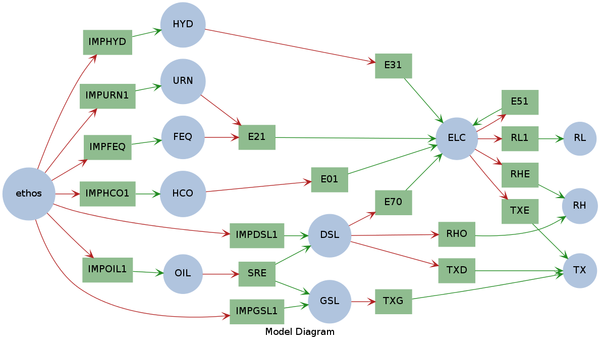Home
Welcome to The TEMOA Project
Tools for Energy Model Optimization and Assessment (Temoa) is an open source modeling framework for conducting energy system analysis. The core component of Temoa is a technology explicit energy economy optimization model. It's similar in design to the MARKAL / TIMES model generators, OSeMOSYS, and MESSAGE. Such models have emerged as critical tools for technology assessment and policy analysis at scales ranging from local to global. Technology explicit models enable a simultaneously broad and deep assessment of technology by considering the economic and technical characteristics of individual technologies as well as their interactions within a well-defined system. The energy system is described algebraically as a network of linked processes that convert a raw energy commodity (e.g., coal, oil, biomass, uranium) into an end-use demand (e.g., lighting, transport, water heating, conditioned air), often through a series of one or more intermediate commodities (e.g., electricity, gasoline, ethanol). Each technology is defined by a set of engineering, economic, and environmental characteristics (e.g., capital cost, efficiency, emissions rate) associated with converting an energy commodity from one form to another. Technologies are linked to one another in a network via model constraints representing the allowable flow of energy commodities. The model objective is to minimize the present cost of energy supply by deploying and utilizing energy technologies and commodities over time to meet a set of exogenously specified end-use demands. Technology explicit models are formulated as linear programming problems in which linear additions of technology capacity are utilized to meet end-use demands.
The design of Temoa is intended to fulfill a unique niche within the energy modeling community by addressing two critical shortcomings: an inability to conduct third party verification of published model-based results and the difficulty of conducting rigorous uncertainty analysis with large, complex models. Temoa leverages a modern revision control system to publicly archive model source and data, which enables third party verification of all published modeling work. In addition, Temoa represents the first EEO model to be designed - from its initial conceptualization - for operation within a high performance computing environment.

This image was dynamically generated with an open source graphing utility called Graphviz. This particular image represents a simple test case called 'utopia' (developed for MARKAL) that was used in early model verification exercises. Energy technologies are represented by green boxes and energy commodities by blue circles. Commodity flow into each technology is represented by green arrows, flow out by red arrows. Energy sources are shown on the left edge of the diagram (i.e., the import technologies), and on the right edge are the end-use demands (i.e., residential lighting, heating, and transportation). You can click on the diagram to explore the results for model year 1990.
Learn more about TEMOA, get support in our forum, peruse our code, or simply get in contact with us.
 This material is based upon work supported by the National Science Foundation under Grant No. 1055622. Any opinions, findings, and conclusions or recommendations expressed in this material are those of the author(s) and do not necessarily reflect the views of the National Science Foundation.
This material is based upon work supported by the National Science Foundation under Grant No. 1055622. Any opinions, findings, and conclusions or recommendations expressed in this material are those of the author(s) and do not necessarily reflect the views of the National Science Foundation.
 The TEMOA Project
The TEMOA Project